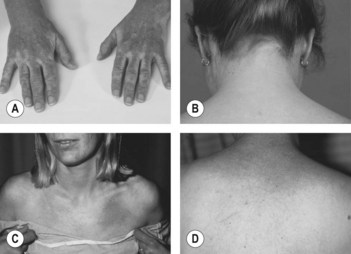63 Dermatomyositis
Salient features
History
• The adult form usually occurs after the age of 40 years
• Weakness of proximal muscles evolving over weeks or months: difficulty in getting from a low chair or squatting position, climbing stairs, lifting and running
• Dysphagia (caused by weakness of the muscles of the pharynx)
• Ask the patient whether the red rash is made worse by exposure to sunlight
• Heliotrope rash or purplish-blue rash around the eyes, back of the hands, dilated capillary loops at the base of fingernails, erythema of knuckles accompanied by a raised violaceous scaly eruption (Gottron’s sign); the erythema spares the phalanges (unlike that of SLE in which the phalanges are involved and the knuckles are spared)
• Erythematous rash may be present on the neck and upper chest (often in the shape of a V), shoulders (shawl sign), elbows, knees and malleoli
• Cuticles may be irregular, thickened and distorted; the lateral and palmar areas of the fingers become rough and cracked with irregular ‘dirty’ horizontal lines, resembling those in a mechanic’s hands.
Note: In dermatomyositis, the myopathy is accompanied by a rash, which includes three classic types:
Stay updated, free articles. Join our Telegram channel

Full access? Get Clinical Tree



